Amateur Radio Satellites
Amateur radio satellites are artificial satellites (as opposed to natural ones such as the Moon) which built and used by amateur radio operators. Many of these satellites receive an OSCAR designation (Orbiting Satellite Carrying Amateur Radio), but not all. These satellites are free to use and may be designed to act as repeaters, linear transponders and digital relays. Amateur radio satellites (or AMSATs) can support FM voice, SSB voice, digital communications and even Morse code.



The other tricky aspect of making a satellite contact is that one must track the satellite as it passes overhead (azimuth and elevation). There is software available that will do this but one has to download the orbital parameters of the satellite from the North American Air Defense Command (NORAD). This combined organization of the United States and Canada tracks satellites orbiting the Earth and the parameters are known as Keplerian Elements. Amateur radio software will download these elements as an update - for example Ham Radio Deluxe and Gpredict and Orbitron. Alternatively one can track satellites manually at https://www.amsat.org/track/ .
Typically an amateur radio satellite operates with an uplink frequency and a downlink frequency. If the frequencies are on different bands we call this a cross-band repeater. During a pass of a satellite, these frequencies will appear to vary from the frame of reference of the Earth due to the Doppler effect. Astronomers might call this the red shift (going away - lower frequencies) and the blue shift (approaching - higher frequencies). In satellite phones or GPS devices, internal software compensates for this effect but in amateur radio operations the effect is very noticeable and can be handled manually or with software that automatically adjusts the radio's frequency. Other effects include changing polarization as the satellite tumbles relative to the ground station - so the antenna needs to be able to handle this (or the holder of the Arrow antenna can simply rotate the antenna too).
A satellite that receives a signal and then retransmits it, will do so towards the Earth. That portion of the satellite visible from the surface of the Earth (line of sight) is the satellite's footprint. Any amateur station within that footprint will receive the transmission from the satellite. This results in a huge area and the potential for long distance contacts with low power and a handheld radio. In the case of UO-11 in the image above, the footprint has a radius of 5,486 km. Of course the duration of the pass will be only a few minutes...
It is common for amateur radio contacts to be made from Earth via the International Space Station. There is a repeater on board and it is activated during Field Day. Sometimes the astronauts will speak directly to the Earth station. Sometimes contacts with schools are arranged - ARISS. There is also a packet repeater on board and APRS is a possibility as are signals sent by Slow Scan Television. See the video links below.
Sources:
- https://www.dxzone.com/catalog/Software/Satellite_tracking/
- https://amsat-uk.org/beginners/satellite-tracking/
- https://www.youtube.com/watch?v=MpZqaVwaIYk
- https://www.youtube.com/watch?v=h73EYcyszf8
- https://nwtresearch.com/
- https://nwtresearch.com/about/regional-research-centres/western-arctic-research-centre
- https://albertasat.ca/northern-spirit/
- https://www.ettus.com/product-categories/usrp-bus-series/
- https://www.asc-csa.gc.ca/eng/Default.asp
- https://www.asc-csa.gc.ca/eng/astronomy/northern-lights/default.asp
- https://en.wikipedia.org/wiki/Amateur_radio_satellite
- https://www.amsat.org/
- https://www.dummies.com/programming/ham-radio/how-to-operate-ham-radio-via-satellite/


